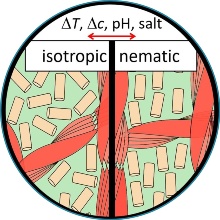Lyotropic liquid crystal gels are soft solids that combine the inherent long-range order of a surfactant based lyotropic liquid crystal (LLC) with the structural integrity of a physical (hydro-)gel network [1,2]. The richness of self-assembled LLC structures combined with the increasing availability of efficient low‑molecular weight gelators (LMWGs) open a broad avenue to new soft, anisotropic and water-based materials which make use of advantageous properties of both the lyotropic liquid crystal and the gel. LLC gels are potentially interesting for biomedical application, as the LLC can solubilize water‑insoluble drugs, while the gel-like consistency allows for an easy but effective application. Another potential application for LLC gels is as new water-based stimuli responsive materials for sensors and actuators. The monodomains of LLC gels are the lyotropic counterpart to thermotropic liquid crystal elastomer (LCE) monodomains which find frequent use in the fields of soft robotics and biomimetic actuation. Compared to their thermotropic counterparts LLC gels are cheap in fabrication, compatible with aqueous systems and might thus respond to a broader range of chemical and biological stimuli. The ultimate goal of this project is to explore the potential of LLC gels as stimuli responsive materials. To that end the availability of (mainly) nematic LLC gels with tailored thermal, structural and rheological properties has to be determined and the successful fabrication of aligned LLC gel samples with well-defined and macroscopically anisotropic director configurations achieved.
|
[1] R. G. Weiss, P. Térech, in Molecular Gels. Materials with Self-Assembled Fibrillar Networks (Eds.: R. G. Weiss, P. Terech), Springer, Dordrecht, 2006, chapter 1. |
|
[2] C. Stubenrauch, F. Gießelmann, Angew. Chem. Int. Ed. 2016, 55, 3268. |
Contact
Max Dombrowski
PhD Student

Cosima Stubenrauch
Prof. Dr.Dean of Faculty
- Profile page
- +49 711 685 64470
- Write e-mail
- Secretary: Room 9-302; Tel. +49 711 685-64451 and -64393; sekretariat2@ipc.uni-stuttgart.de



